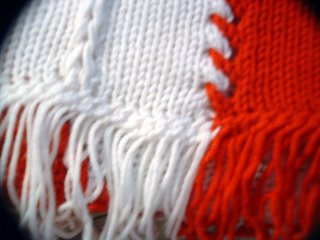My hat was inspired by the Rasta Hat pattern from Knitty Gritty on DIY. Here's the link to their pattern if you want to have go at it
http://www.diynetwork.com/diy/na_knitting/article/0,2025,DIY_14141_5312018,00.htmlI used 2 (2oz) balls of Peaches and Cream 4 ply Worsted Weight 100% cotton, ya know, the stuff that makes the great wash cloths. Size 7 - 16" circular needles and size 9 - 16" circular needles and 4 size 9 double point needles when the decreased sections were too small for the circs.
CO 76 sts. join for circle place marker for start of round and K1P1 rib for 1 1/4" slipping marker as you come to each round.
Row 1: K2 M1 around in plain knit stitch, slip marker, 114 stitches on needle.
Row 2 - 6: Knit, slip marker each round
Row 7: *yo K2tog* repeat around, slip marker
Row 8: Knit, slip marker
Row 9: *yo K2tog* repeat around, slip marker
Row 10: Knit 4 more rounds., slip marker each round
Repeat rows 7 - 10 until piece measures 6 to 10 inches. Length will depend on how much hair/dreds you are tucking into the hat. End with 3 rows of plain knit, the 4th row you will split into 6 sections of 19 stitches using markers so you know where to do your decreases.
This is the tricky part. You will be alternating a decrease row with a plain knit row, while maintaning your established lace pattern. What happened with me was that I ended up having to fudge it here and there with the yarn overs but it all worked out fine.
Decrease row *ssk (a left slant decrease) knit in established pattern to 2 stitches before marker, k2tog (a right slant decrease) slip marker* repeat between *.
Knit next row even in established pattern. Change to double point needles when number of stitches will no longer stretch around the circular needles.
Decrease to 2 stitches between sections, a total of 12 stitches. Using a yarn needle gather up these remaining stitches, pull tight and tack closed.
You can leave your hat like this or you can add the brim. The brim is kind of what makes the hat cool in my opinion :) But if you choose not to, just thread a 21 inch length of cord elastic through the inside loops of your ribbing, I did mine the first row after the cast on row, tie a not and weave in the ends.
For the Brim:
Row 1: pick up and knit the 16 center sts
Row 2: Purl
Row 3: K2, M1, place marker, K12, place marker, knit 2 and pick up next 2 sts from cast on row knitwise
Row 4: Purl to end, pick up one more st from cast on row purlwise
Row 5: K to marker, M1, Slip marker, K12 center sts, slip marker, M1, knit to end, pick up next 2 sts from cast on row knitwise
Row 6: Purl to end, pick up 2 more sts from cast on row purlwise
Repeat rows 5 and 6 until brim measures 2" from center
Next row: (RS) Purl 1 row (turning row)
Next row: (WS) BO first two stitches, but slip first stitch before binding off rather than purling it. Purl to end.
Next row: (RS) BO first two stitches, slipping first stitch before BO instead of knitting it. Knit to 2 stitches before marker, SSK, Slip marker, knit next 12 stitches, slip marker, K2tog knit to end.
Repeat last 2 rows until only 16 stitches remain.
BO 16 remaining stitches.






 Is it ready yet? Stimpy is the curious one :)
Is it ready yet? Stimpy is the curious one :)










